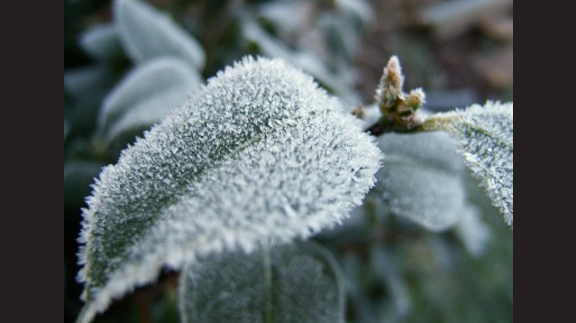Outdoor
With freezing weather on the way, plants need care, too.

By: Kathleen Phillips
Writer: Kathleen Phillips, 979-845-2872, [email protected]
COLLEGE STATION — As the first major cold snap approaches, people can take action to protect plants from total loss, horticulturists with Texas A&M AgriLife Extension Service said.
The first step is to understand how cold temperatures impact different plants and then take steps to alter those conditions, according to Monte Nesbitt of College Station and Robert “Skip” Richter of Houston, both AgriLife Extension horticulturists.
Nesbitt and Richter are co-authors of “Protecting Landscapes and Horticultural Crops from Frosts and Freezes,” which has detailed instructions and is downloadable for free at www.agrilifebookstore.org/.
The National Weather Service has issued a special statement indicating that freezing temperatures could reach south of San Antonio by week’s end. A hard freeze is expected in the Panhandle.
In addition to seeking local weather reports, one needs to understand the difference between frosts and freezes, they said, as well as how topography, urban microclimates and bodies of water can impact a plant’s ability to withstand temperature variations.
“Plants can get used to freezing weather if they are exposed to it consistently and gradually,” Nesbitt explained. “But in Texas, intermittent warm periods can make it hard for plants to adjust and therefore be more vulnerable to frost or freeze damage.”
A sudden, steep plunge in temperatures such as the forecasters are calling for this week could bring about a freeze that includes winds, cold air masses, clouds and precipitation over a period of days as it moves across the state, the horticulturists said.
“For plants, that means damage from the low temperatures as well as from the wind from the stalk to the top,” Richter said. “When the water inside plant cells freezes, ice crystals form that can pierce and damage the cell walls, killing the cells. As temperatures rise, fluids leak out of those cells, and they begin to decay.”
A frost, by contrast, happens when the sky is clear and there isn’t much wind, he said. The amount of radiation given to the plant by the sun is lost gradually during the night to the freezing point just before sunrise. Frosts can be severely damaging as well, but normally only at the top or most exposed part of the plant, he said.
Understanding what is likely for a particular area where plants are growing can help determine the type of protection offered, the horticulturists said.
Frosts are easier to protect plants from, Nesbitt said. Plants growing under tree canopies will be impacted less than those more exposed. Likewise, plants in pots can be placed under the overhang of a house for some protection.Where possible, the best protection would be from opaque covers such as sheets, blankets, cardboard boxes or trash cans, but wait until early evening so the plant can absorb as much sun radiation as possible.
“The idea is to slow the cooling of the plant,” Nesbitt said.
Freezes are not easily deflected by the methods used for a frost, Richter said.
While a cover by itself would not be adequate during a freeze, adding a heat source such as a string of outdoor lights can help, because it adds heat,he said. Plants in containers are more likely to be harmed than those in the ground because they lack the insulation that the Earth provides.
“Move container plants inside the home or garage,” Richter said. “If they can’t be moved indoors, put them on a more protected side of the house. Then water them well and pile on mulch, leaves or hay and cover with a frost blanket.”
Plants that are permanently set in the landscape can receive some protection from semi-permanent structures such as polyethylene film-covered structures(hoop houses, for example), windbreaks, and mounds of soil or mulch heaped around the lower trunk, the horticulturists said.
Nesbitt said the process of protecting plants usually needs to be repeated throughout the winter months since Texas weather cycles between warm and cold for months.
He said to wait to prune frost- or freeze-damaged plants until the spring, because the dead foliage can provide a protective layer during the next cold spell and because pruning could prompt new, tender growth.
-30-
Outdoor
Grazing North Texas: Rescuegrass

By Tony Dean, [email protected]
If moisture is adequate, there are several winter annual grasses that dominate the landscape during early spring in Texas. One of the most common is Rescuegrass.
This winter annual is native to South America but grows over much of the United States and can be found in all ecoregions of Texas. Rescuegrass is easily recognized by its flat seed head.
Numerous seed heads produce seed that is transported by animals and can quickly spread to other areas.
To read more, pick up a copy of the April issue of NTFR magazine. To subscribe by mail, call 940-872-5922.
Outdoor
The Garden Guy

By Norman Winter | Horticulturist, Author, Speaker
The National Garden Bureau has designated 2024 as the ‘Year of the Angelonia’ and I am in full celebration mode. As I was preparing for my contribution to the celebration, I was, however, sent into taxonomic trauma.
For the last 26 years of deep love for the Angelonia, or summer snapdragon, I have told everyone via newspaper, radio and television that they were in the Scrophulariaceae family. Since most gardeners don’t like those words, I modified or simplified the snapdragon family, but somebody has tinkered with green industry happiness and moved Angelonia to the Plantaginaceae or plantain family. I immediately reached out to my friend Dr. Allen Ownings, Horticulture Professor Emeritus with the Louisiana State University AgCenter. I said, “Did you know this, or better yet, did you do it?” He said, as I expected, that the Taxonomist group had done it. This reminded me that someone once said taxonomists have to eat, too.
To read more, pick up a copy of the April issue of NTFR magazine. To subscribe by mail, call 940-872-5922.
Outdoor
Parting Shot: Grit Against the Storm…

By Jelly Cocanougher
Brazen rumbles cut through the daylight stillness. Enamored by the grandiose symphony of the firmament, tinged in anticipation from where the light will snap next.
The clouds dance in the sky as a love letter to the electrically-charged synergy of the ground and air. It moves unashamed, reckless, and bold. It is raw power that could command attention for any being, a reminder that we are attuned to the primal opus of flora and fauna. The spirit of the prairie was awakened, the hands of a cowboy rests at the heart of it all, a symphony in combination.
-

 Country Lifestyles1 year ago
Country Lifestyles1 year agoScott & Stacey Schumacher: A Growth Mindset
-

 Equine7 months ago
Equine7 months agoThe Will to Win
-

 Country Lifestyles7 years ago
Country Lifestyles7 years agoStyle Your Profile – What your style cowboy hat says about you and new trends in 2017
-

 Country Lifestyles4 years ago
Country Lifestyles4 years agoAmber Crawford, Breakaway Roper
-

 HOME7 years ago
HOME7 years agoGrazing North Texas – Wilman Lovegrass
-

 Country Lifestyles7 years ago
Country Lifestyles7 years agoDecember 2016 Profile, Rusty Riddle – The Riddle Way
-

 Country Lifestyles8 years ago
Country Lifestyles8 years agoJune 2016 Profile – The man behind the mic: Bob Tallman
-

 Outdoor9 years ago
Outdoor9 years agoButtercup or Primrose?






